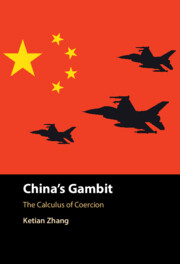Book contents
- China’s Gambit
- China’s Gambit
- Copyright page
- Dedication
- Contents
- Figures
- Acknowledgments
- Abbreviations
- 1 Introduction
- 2 The Cost-Balancing Theory
- 3 Coercion in the South China Sea
- 4 Sino-Japanese Disputes in the East China Sea
- 5 Coercion in Cross-Strait Relations
- 6 Tibet and the Dalai Lama Visits
- 7 Conclusion
- References
- Index
4 - Sino-Japanese Disputes in the East China Sea
Published online by Cambridge University Press: 30 November 2023
- China’s Gambit
- China’s Gambit
- Copyright page
- Dedication
- Contents
- Figures
- Acknowledgments
- Abbreviations
- 1 Introduction
- 2 The Cost-Balancing Theory
- 3 Coercion in the South China Sea
- 4 Sino-Japanese Disputes in the East China Sea
- 5 Coercion in Cross-Strait Relations
- 6 Tibet and the Dalai Lama Visits
- 7 Conclusion
- References
- Index
Summary
Chapter 4 focuses on Chinese coercion in the East China Sea, where China has maritime territorial and jurisdictional disputes with Japan. I explain the trend of Chinese coercion in the East China Sea while conducting two in-depth case studies: the Sino-Japan boat clash incident of 2010 and the incident of Senkaku nationalization in 2012. As the cost-balancing theory argues, the costs and benefits of coercion explain when and how China coerces. In the pre-2005 period, the need to establish resolve was generally low, whereas the economic cost was high. China, therefore, refrained from coercion. The need to establish resolve was briefly higher in 1996 and 1997, but China did not utilize coercion in these cases because of its equally high need for resolve and high economic costs. Because the East China Sea is not China’s core interest, its issue importance is not sufficiently high to justify the use of coercion. When the need to establish a reputation for resolve is high and the economic cost low, China used coercion, as seen in the post-2005 trend and, in particular, the 2010 and 2012 cases. It refrained using from military coercion for fear of potential geopolitical backlash.
- Type
- Chapter
- Information
- China's GambitThe Calculus of Coercion, pp. 97 - 129Publisher: Cambridge University PressPrint publication year: 2023



